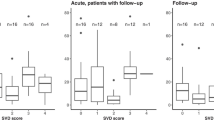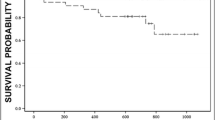Abstract
Severe obstructive sleep apnea (OSA) increases the risk of stroke recurrence and mortality after stroke. Since nocturia is common in post-stroke patients with OSA, this study explored the predictive role of nocturia for severe OSA in patients with ischemic stroke. This was a cross-sectional, prospective study involving 65 consecutive patients with ischemic stroke admitted to rehabilitation ward. All participants received polysomnography and clinical assessments, including a 3-day urinary frequency–volume recording. Differences in study variables between patients with and without severe OSA were compared, and logistic regression analyses with backward selection procedures were used to assess the relationship between OSA severity and nocturia. Patients with severe OSA were older (69.6 ± 9.9 vs. 62.6 ± 11.5 year), had a significantly higher desaturation index (37.9 ± 16.1 vs. 8.8 ± 6.1 episodes/night) and had a higher frequency of nocturia (2.2 ± 1.0 vs. 1.5 ± 0.8 episodes/night) than those without. In addition, men with severe OSA had a larger neck circumference (409 ± 26 vs. 381 ± 32 mm) than those without. The frequency of nocturia, age, sex, and interaction between sex and neck circumference remained significant in the final regression model for severe OSA. In this model, the area under the receiver operating characteristic curve was 0.87 (95% CI 0.79–0.96; P < 0.001) with sensitivity and specificity of 80.6 and 82.8%, respectively. The odds ratio of nocturia was highest (3.5) among the four variables. Nocturia is an independent predictor for severe OSA, and the final prediction model might be used when screening for severe OSA in patients with ischemic stroke.

Similar content being viewed by others
References
McNicholas WT, Bonsigore MR, Management Committee of EU COST ACTION B26 (2007) Sleep apnoea as an independent risk factor for cardiovascular disease: current evidence, basic mechanisms and research priorities. Eur Respir J 29:156–178
Kaneko Y, Hajek VE, Zivanovic V, Raboud J, Bradley TD (2003) Relationship of sleep apnea to functional capacity and length of hospitalization following stroke. Sleep 26:293–297
Martinez-Garcia MA, Soler-Cataluna JJ, Ejarque-Martinez L, Soriano Y, Roman-Sanchez P, Illa FB, Canal JM, Duran-Cantolla J (2009) Continuous positive airway pressure treatment reduces mortality in patients with ischemic stroke and obstructive sleep apnea: a 5-year follow-up study. Am J Respir Crit Care Med 180:36–41
Lam B, Ip MSM, Tench E, Ryan CF (2005) Craniofacial profile in Asian and white subjects with obstructive sleep apnoea. Thorax 60:504–510
Maislin G, Pack AI, Kribbs NB, Smith PL, Schwartz AR, Kline LR, Schwab RJ, Dinges DF (1995) A survey screen for prediction of apnea. Sleep 18:158–166
Netzer NC, Stoohs RA, Netzer CM, Clark K, Strohl KP (1999) Using the Berlin Questionnaire to identify patients at risk for the sleep apnea syndrome. Ann Intern Med 131:485–491
Arzt M, Young T, Peppard PE, Finn L, Ryan CM, Bayley M, Bradley TD (2010) Dissociation of obstructive sleep apnea from hypersomnolence and obesity in patients with stroke. Stroke 41:e129–e134. http://www.stroke.ahajournals.org/cgi/content/abstract/41/3/e129
Oztura I, Kaynak D, Kaynak HC (2006) Nocturia in sleep-disordered breathing. Sleep Med 7:362–367
Kaynak H, Kaynak D, Oztura I (2004) Does frequency of nocturnal urination reflect the severity of sleep-disordered breathing? J Sleep Res 13:173–176
Fitzgerald MP, Mulligan M, Parthasarathy S (2006) Nocturic frequency is related to severity of obstructive sleep apnea, improves with continuous positive airways treatment. Am J Obstet Gynecol 194:1399–1403
Sakakibara R, Uchiyama T, Liu Z, Yamamoto T, Ito T, Yamanishi T, Hattori T (2005) Nocturnal polyuria with abnormal circadian rhythm of plasma arginine vasopressin in post-stroke patients. Intern Med 44:281–284
Brown DL (2006) Sleep disorders and stroke. Semin Neurol 26:117–122
Phillips BA, Berry DT, Lipke-Molby TC (1996) Sleep-disordered breathing in healthy, aged persons. Fifth and final year follow-up. Chest 110:654–658
Hale WE, Perkins LL, May FE, Marks RG, Stewart RB (1986) Symptom prevalence in the elderly. An evaluation of age, sex, disease, and medication use. J Am Geriatr Soc 34:333–340
Hardin-Fanning F, Gross JC (2007) The effects of sleep-disordered breathing symptoms on voiding patterns in stroke patients. Urol Nurs 27:221–224
Dyken ME, Im KB (2009) Obstructive sleep apnea and stroke. Chest 136:1668–1677
Munoz R, Duran-Cantolla J, Martinez-Vila E, Gallego J, Rubio R, Aizpuru F, De La TG (2006) Severe sleep apnea and risk of ischemic stroke in the elderly. Stroke 37:2317–2321
Weiss JP (2006) Nocturia: “do the math”. J Urol 175:s16–s18
Mahoney FI, Barthel DW (1965) Functional evaluation: the Barthel index. Md State Med J 14:61–65
Pack AI (2006) Advances in sleep-disordered breathing. Am J Respir Crit Care Med 173:7–15
Chen NH, Johns MW, Li HY, Chu CC, Liang SC, Shu YH, Chuang ML, Wang PC (2002) Validation of a Chinese version of the Epworth sleepiness scale. Qual Life Res 11:817–821
Natsume O (2006) A clinical investigation of nocturnal polyuria in patients with nocturia: a diurnal variation in arginine vasopressin secretion and its relevance to mean blood pressure. J Urol 176:660–664
van KP, Abrams P, Chaikin D, Donovan J, Fonda D, Jackson S, Jennum P, Johnson T, Lose G, Mattiasson A, Robertson G, Weiss J (2002) The standardisation of terminology in nocturia: report from the Standardisation Sub-committee of the International Continence Society. Neurourol Urodyn 21:179–183
Whittle AT, Marshall I, Mortimore IL, Wraith PK, Sellar RJ, Douglas NJ (1999) Neck soft tissue and fat distribution: comparison between normal men and women by magnetic resonance imaging. Thorax 54:323–328
Pressman MR, Figueroa WG, Kendrick-Mohamed J, Greenspon LW, Peterson DD (1996) Nocturia. A rarely recognized symptom of sleep apnea and other occult sleep disorders. Arch Intern Med 156:545–550
Bliwise DL, Adelman CL, Ouslander JG (2004) Polysomnographic correlates of spontaneous nocturnal wetness episodes in incontinent geriatric patients. Sleep 27:153–157
Pearce DC, Cadilhac DA, Pierce RJ, Thrift AG, David S, Donnan GA (2008) Estimating the prevalence of sleep-disordered breathing in community-based, long-term stroke survivors using a validated predictive model. Cerebrovasc Dis 26:441–446
Broadley SA, Jorgensen L, Cheek A, Salonikis S, Taylor J, Thompson PD, Antic R (2007) Early investigation and treatment of obstructive sleep apnoea after acute stroke. J Clin Neurosci 14:328–333
Brown DL, Chervin RD, Hickenbottom SL, Langa KM, Morgenstern LB (2005) Screening for obstructive sleep apnea in stroke patients: a cost-effectiveness analysis. Stroke 36:1291–1293
Acknowledgments
This work was funded by the Chang Gung Medical Research Council (CMRPG260581). The authors declare that they have no conflict of interest. No commercial party having a direct financial interest in the results of the research supporting this article has or will confer a benefit on the author(s) or on any organization with which the author(s) is/are associated.
Author information
Authors and Affiliations
Corresponding author
Rights and permissions
About this article
Cite this article
Chen, CY., Hsu, CC., Pei, YC. et al. Nocturia is an independent predictor of severe obstructive sleep apnea in patients with ischemic stroke. J Neurol 258, 189–194 (2011). https://doi.org/10.1007/s00415-010-5705-2
Received:
Accepted:
Published:
Issue Date:
DOI: https://doi.org/10.1007/s00415-010-5705-2




